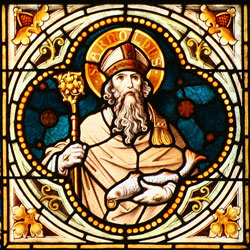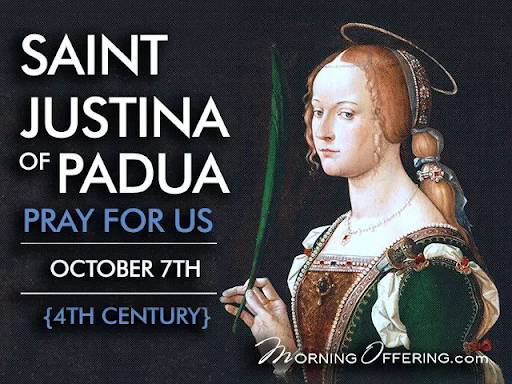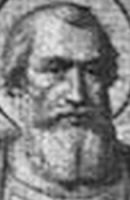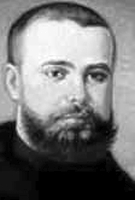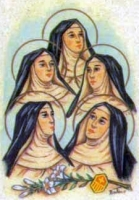St. Artaldus
Feastday: October 7
Birth: 1101
Death: 1206
Artaldus (also called Arthaud) was born in the castle of Sothonod in Savoy. At the age of eighteen, he went to the court of Duke Amadeus III, but a year or two after, he became a Carthusian at Portes. After many years, being a priest and an experienced and holy religious, he was sent by the prior of the Grande Chartreuse to found a charterhouse near his home, in a valley in the Valromey significantly called "the cemetery". Here Artaldus established himself with six of his brethren from Portes. The community was no sooner well settled down, than there buildings were destroyed by fire, and St. Artaldus had to begin all over again. He chose a fresh site on the Arvieres River, and his second foundation was soon built and occupied. But a Carthusian cell could not contain the ever-increasing reputation of Artaldus: like his master St. Bruno, he was consulted by the Pope, and when he was well over eighty, he was called from his monastery to be bishop of Belley, in spite of his vehement and reasonable protest. However, after less than two years of episcopate, his resignation was accepted, and he thankfully returned to Arvieres, where he lived in peace for the rest of his days. During his last years, he was visited by St. Hugh of Lincoln, who had come into France, and who, while he was prior of the charterhouse of Witham, had induced Henry II to become a benefactor of Arvieres. The Magna vita of St. Hugh records a gentle rebuke administered by Hugh when Artaldus asked him for political news in the presence of the community who had turned their backs upon the world to give themselves entirely to God. The cultus of St. Artaldus, called simply Blessed by the Carthusians, was confirmed for the diocese of Belley in 1834. He was 105 years old when he died and his feast day is October 7th.
Early life
Born in the castle of Sothonod in Savoy, in 1101. Much of his childhood is not known but at the age of eighteen, Artaldus entered the court of Duke Amadeus III, but after a year or so he left to become a priest.
Early religious life
Artaldus entered the Carthusian house of Portes Charterhouse in modern-day Bénonces. There he was ordained a priest. He spent many years serving as a priest before being sent by the prior of the Grande Chartreuse to found a charterhouse near a valley in the Valromey, a place that was known as "the cemetery". Artaldus decided to take with him six fellow priests from the Portes Charterhouse to establish this new community. The community had to move when the newly built charterhouse buildings were ravaged by fire. Artaldus chose a fresh site on the Arvières River, and the Arvières Charterhouse was founded and dedicated to Our Lady, in 1132.
In the years spent at Arvière, Artaldus gained considerable fame and a great reputation, like that of St. Bruno, his master. Similar to St. Bruno, Artaldus was called from his monastery, to accept the role of serving as a bishop. This was at the See of Belley. Artaldus, who was over eighty when called to the post, less than two years later he resigned and returned to Arvières.
Later life and death
In his later years Artaldus was visited by Hugh of Lincoln, who had convinced King Henry II of England to become a benefactor of the charterhouse at Arvières. Artaldus who live the remainder of his days at Arvières, living until the age of 105, he died in 1206. His cultus was confirmed in 1834, by Pope Gregory XVI.
Saint Libaire the Great
Also known as
Lievière
Additional Memorials
• 8 October (Toul-Nancy, France)
• Pentecost Monday (procession in Grand, France commemorating the return of the relics)
• 1st Sunday in October (procession in Grand, France)
Profile
Born to an imperial Roman patrician family, the daughter of Baccius Lientrude and sister of Saint Amée, Saint Francule, Saint Gontrude, Saint Hoilde, Saint Lintrude, Saint Menne, Saint Ode, Saint Pusinne and Saint Suzanne. She worked for her family as a shepherdess, spending her time with the flocks spinning, praying and singing hymns. While travelling, emperor Julian the Apostate found her in the field and tried to get her to renounce Christianity by showing her a golden statue of Apollo; she struck it with her distaff and the statue fell apart. Martyr. Legend says that a healing spring sprang from the place of her murder, and that her body picked up the severed head and carried it back to town where she combed out the hair to make it more presentable before burial.
Born
mid-4th century Roman imperial Gaul (in modern France)
Died
• beheaded in 362 at the 2nd milepost of Apollogranum, Gaul (in modern France)
• relics sent to the canons of Saint-Léon, Toul, France in 1657 to protect them from Protestant raiders
• some relics (including a comb Libaire used to comb her hair after being beheaded) enshrined in Grand, Vosges, France on 5 February 1793
• relics re-enshrined in Grand in 1804
• relics re-enshrined in Grand in 1874
• some relics enshrined in Rambervillers, France
• some relics enshrined in Burey-en-Vaux, France
• some relics enshrined in Lépanges-sur-Vologne, France
• some relics enshrined in Affracourt, France
• some relics enshrined in Damelevières, France
• some relics enshrined in Sainte-Livière, Haute-Marne, France
Our Lady of the Rosary
தூய ஜெபமாலை அன்னை
1571 ஆம் ஆண்டு கிறிஸ்தவர்களுக்கும் இஸ்லாமியருக்கும் இடையே லாபந்தோ என்னும் இடத்தில் கடுமையாகப் போர் நடந்தது. இந்தப் போரில் கிறிஸ்தவர்களே வெற்றி பெற்றார்கள். இதற்கு அடிப்படைக் காரணம் உரோமை நகரில் இருக்கக்கூடிய தூய பேதுரு சதுக்கத்தில் கிறிஸ்தவர்கள் தங்களுடைய கைகளில் ஜெபமாலை ஏந்தி அன்னை மரியாவிடம் ஜெபித்ததே ஆகும். அன்னை மரியாவே எதிரிகளிடமிருந்து கிறிஸ்தவர்களுக்கு வெற்றியைத் தேடித்தந்ததால் அப்போது திருத்தந்தையாய் இருந்த ஐந்தாம் பவுல் இதனை அன்னை மரியின் வெற்றியின் விழா என்று கொண்டாடப் பணித்தார்.
ஜெபமாலை சொல்லும் வழக்கம் பதிமூன்றாம் நூற்றாண்டிலிருந்தே இருந்திருக்கிறது என்று வரலாற்று ஆசிரியர்கள் சொல்வார்கள். பதிமூன்றாம் நூற்றாண்டின் தொடக்கத்தில் இயேசுவின் இறைத்தன்மையை மறுக்கும் அல்பிஜீயன்ஸ் என்ற தப்பறைக் கொள்கை திருச்சபைக்கு அதிகமாக ஊறுவிளைவித்து வந்தது. இதை எதிர்த்து டொமினிக் எனப்படும் சாமிநாதர் அதிகமாகப் போராடி வந்தார். ஆனாலும் அவரால் வெற்றிகொள்ள முடியவில்லை. எனவே அவர் காட்டிற்குச் சென்று கடுமையான தவ முயற்சிகளை மேற்கொண்டார். அவர் தவ முயற்சிகளை மேற்கொண்ட மூன்றாம் நாளில் மரியா அவருக்குக் காட்சி கொடுத்து, “இந்த ஜெபமாலையை வைத்து நம்பிக்கையோடு ஜெபி, நிச்சயம் வெற்றி கிடைக்கும்” என்று சொல்லிவிட்டு மறைந்தார். மரியா சொன்னதற்கு ஏற்ப சாமிநாதர் தன்னுடைய இடத்திற்குச் சென்று ஜெபமாலை சொல்லி ஜெபித்தார். இதனால் அல்பிஜீனியன்ஸ் என்ற தப்பறைக் கொள்கையை பின்பற்றி வந்த மக்கள் மனம்மாறி இயேசுவை இறைமகனாக ஏற்றுக்கொண்டார்கள். அதன்பிறகு ஜெபமாலை சொல்லும் வழக்கம் மக்களிடத்தில் அதிகமாகப் பரவி வந்தது.
ஆலன் ரோச் என்ற புனிதர் ஜெபமாலை சொல்லும் வழக்கத்தை மக்களிடத்தில் அதிகமாகக் கொண்டு போய் சேர்த்தார். ஜெபமாலை சொல்வதனால் கிடைக்கும் நன்மைகள் என்ன என்பதைப் பற்றியும் தெளிவாக மக்களிடத்தில் எடுத்துச் சொன்னார். 1571 ஆம் ஆண்டு கிறிஸ்தவர்கள் இஸ்லாமியப் படையை செபமாலையின் துணைகொண்டு வெற்றிகொண்டதால் செபமாலையின் மீது மக்கள் இன்னும் அதிகமாக நம்பிக்கை கொள்ளத் தொடங்கினார்கள். 1715 ஆம் ஆண்டு இவ்விழா உரோமைத் திருச்சபையின் விழா அட்டவணையில் சேர்க்கப்பட்டது.
இதற்கிடையில் ஜெபமாலை சொல்வது பற்றி நிறைய விமர்சனங்கள் வந்தன. ஜெபமாலை சிறியவர்களும் வயதானவர்களும் சொல்லவேண்டியது அது எல்லாருக்கும் உரித்தானது அல்ல என்பது போன்ற விமர்சனங்களும் வந்தன. இந்த நேரத்தில்தான் 1858 ஆம் ஆண்டு பிப்ரவரி மாதம் 18 தேதி முதல் ஆகஸ்ட் மாதம் 16 தேதி வரை லூர்து நகரில் மரியா பெர்னதெத் என்ற சிறுமிக்குக் காட்சி கொடுத்ததில் ஜெபமாலை சொல்லி ஜெபித்தார். இதனால் ஜெபமாலை என்பது ஒரு குறிப்பிட்ட சாரார் மட்டும் சொல்லவேண்டியது அல்ல, அது எல்லாரும் சொல்லவேண்டியது என்ற வழக்கம் உருவாகியது. 1917 ஆம் ஆண்டு பாத்திமா நகரில் அன்னை மரியா ஜெசிந்தா, லூசியா, பிரான்சிஸ்கா என்ற மூன்று சிறுமிகளுக்குக் காட்சிகொடுத்தபோது தன்னை ஜெபமாலை அன்னை என்றே வெளிப்படுத்தினார். அப்போது அவர் அவர்களிடம் ஜெபமாலை சொல்வதனால் கிடைக்கும் பயன்கள் என்ன என்பது பற்றியும் எடுத்துச் சொன்னார். இவ்வாறு ஜெபமாலை பக்தி திருச்சபையில் படிப்படியாக வளர்ந்தது. 1969 ஆம் ஆண்டு திருத்தந்தை ஆறாம் பவுல் இவ்விழாவை திருச்செபமாலையின் அன்னை விழா என அறிவித்து, அதனை உலகம் முழுவதும் கொண்டாடப் பணித்தார்.
ஜெபமாலை சொல்வது என்பது, ஏதோ சொன்ன ஜெபத்தை திரும்பத் திரும்பச் சொல்வது கிடையாது. நாம் ஜெபமாலை சொல்கிறது இயேசுவின் பிறப்பு, வளர்ப்பு, இறப்பு, அவருடைய உயிர்ப்பு ஆகியவற்றை மரியாவின் வாழ்வோடு இணைத்து தியானிக்கின்றோம். அது மட்டுமல்லாமல் ஜெபமாலையை நாம் சொல்லி ஜெபிக்கின்றபோது நம்முடைய ஐம்புலன்களும் ஒன்றாகச் சேர்ந்து இயங்குகின்றன. அதலால் இதனை ஒரு மிகச் சிறந்த பக்தி முயற்சி என நாம் உணர்ந்துகொள்ளலாம்.
தூய லூயிஸ் தே மான்போர்ட் என்பவர் செபமாலையைக் குறித்து இவ்வாறு கூறுவார், “ஜெபமாலை சொல்கிறபோது நமக்கு வரும் தீவினைகள் முற்றிலுமாக நீங்கும். இறையருள் நமக்கு மேலும் மேலும் பெருகும்” என்று. திருத்தந்தை பனிரெண்டாம் பத்திநாதரோ, “ஜெபமாலை என்பது சாதாரண விஷயம் கிடையாது. அதனைச் சொல்லி ஜெபிக்கின்றபோது மீட்பின் வரலாற்றை நினைவுகூறுகின்றோம்; ஆண்டவர் இயேசு நமக்குச் சொல்லிக் கொடுத்த ஜெபத்தினை நினைவுகூறுகின்றோம்; வானதூதர் கபிரியேல் மரியாவிற்குச் சொன்ன மங்கள வார்த்தையை நினைவுகூறுகின்றோம்” என்பார்.
ஆகவே, நாம் அனுதினமும் சொல்லக்கூடிய செபமாலையின் உட்பொருளையும் வல்லமையையும் உணர்ந்தவர்களாய் நம்பிக்கையோடு ஜெபமாலை சொல்லி ஜெபிப்போம்.
Also known as
• Feast of the Most Holy Rosary
• Our Lady of the Holy Rosary
• Our Lady of the Most Holy Rosary
• Our Lady of Victory
About
On Sunday 7 October 1571 the combined Christian fleets under Don John of Austria achieved a significant naval victory over the Turks in the Straits of Lepanto. Thousands of Christians were liberated, the Turkish fleet was destroyed, and they suffered their first great defeat at sea. In gratitude to God and Our Lady, Pope Saint Pius V ordered an annual commemoration to be made of Our Lady of Victory. In 1573 Pope Gregory XIII transferred the feast to the first Sunday of October with the title Feast of the Most Holy Rosary since the victory was won through invocation of Our Lady of the Rosary. In 1716 Pope Clement XII extended the feast to the whole Latin Rite calendar, assigning it to the first Sunday in October. Pope Saint Pius X changed the date to 7 October in 1913. In 1969 Pope Paul VI changed the name of the feast to Our Lady of the Rosary.
Saint Justina of Padua
பதுவை நகர புனிதர் ஜஸ்டினா
மறைசாட்சி:
இறப்பு: கி.பி. 304
ஏற்கும் சமயம்:
ரோமன் கத்தோலிக்க திருச்சபை
முக்கிய திருத்தலம்:
புனிதர் அந்தோனியார் ஆலயம், லிஸ்பன் நகர்
பாதுகாவல்:
பதுவை, பல்மநோவா
நினைவுத் திருவிழா: அக்டோபர் 7
புனிதர் ஜஸ்டினா, பதுவை நகரின் பாதுகாவலரும், கத்தோலிக்க புனிதரும் ஆவார். இவர், பதுவை நகரின் அரச பரம்பரையில் பிறந்தவரும் கன்னியரும் ஆவார். அவர் இளவரசியாக முடி சூடப்பட்டவர் என்றும், மார்பிலே கூரிய வாள் ஒன்றினை அணிந்திருந்தவர் என்றும் கிறிஸ்தவ கலைகள் கூறுகின்றன.
ஆறாம் நூற்றாண்டில், பதுவை நகரின் பொதுநிலையினர், புனித ஜஸ்டினாவுக்காக ஒரு பேராலயத்தினை அர்ப்பணித்தனர். 'எப்ரேஷியன் பேராலயத்தின்' (Euphrasian Basilica) 'பிரிஸ்பிட்டரி வளைவின்' (Presbytery arch) இடது பக்கத்திலுள்ள மறைசாட்சிகளாய் மறைந்த அருட்கன்னியரின் சித்திரங்களில் இவரது சித்திரமும் உள்ளது. 'சாண்ட அப்போலினரிஸ் (Sant'Apollinare Nuovo) பேராலயத்தில் நடைபெறும் அருட்கன்னியரின் ஊர்வலத்தில் இவரும் இடம்பெற்றுள்ளார்.
ஜஸ்டினா, அப்போஸ்தலர் புனித பேதுருவின் சீடர் என்று இடைக்கால சரித்திர வரலாறுகள் கூறுகின்றன. பதுவை மறை மாவட்டத்தின் முதலாம் ஆயரான 'புனித ப்ராஸ்டாசிமஸ்' (Saint Prosdocimus) ஜஸ்டினாவின் ஞானத்தந்தை என்றும் கூறுகின்றன. 'புனித ப்ராஸ்டாசிமஸின்' வரலாறு, அவர் அப்போஸ்தலர் புனித பேதுருவால் அந்தியோக்கியாவிலிருந்து அனுப்பப்பட்டவர் என கூறுகிறது.
எப்படியாகினும், மேற்கூறப்பட்ட கூற்றுக்கள் நடைமுறையில் சாத்தியமற்றவை. காரணம், கி.பி. 304ம் ஆண்டு வாழ்ந்த இளம்பெண்ணான ஜஸ்டினாவுக்கு கி.பி. 100ம் ஆண்டு மரித்த புனிதர் ப்ராஸ்டாசிமசை சந்தித்திருக்க வாய்ப்பே இல்லை.
பதுவையின் பாதுகாவலரான ஜஸ்டினா, புனித மாற்குவின் பிறகு, வெனிஸ் நகரினதும் இரண்டாம் பாதுகாவலராவார்.
Profile
Young woman who took private vows of chastity and devotion to God. Martyr in the persecutions of Diocletian. Some mideaval documents describe her as a disciple of Saint Peter the Apostle, but that's impossible. She is sometimes depicted in art as a nun, but never was, and some artists may have confused her with Saint Scholastica.
Died
martyred c.304
Saint Osith
Also known as
Osyth, Osgyth, Othith, Ositha, Sythe
Profile
Born a princess, the daughter of Frewald, a Merclan prince of the Hwiccan tribe. Niece to Editha, to whom belonged the town and manor of Ailesbury, and who raised Osith. Educated at the convent school at Aylesbury. Though she was drawn to religious life, Osith was married young to Sighere, king of the East Angles. After giving birth to Offa, who became king of the Angles, Osith became celibate with her husband's consent. He gave her the manor at Chick, which became a monastery under her rule. Killed by Danish invaders for supporting area Christians. Martyr.
Born
at Quarendon, Buckinghamshire, England
Died
• beheaded in 870
• relics at Chick, Essex, England
Pope Saint Mark
புனிதர் மாற்கு திருத்தந்தை
34ம் திருத்தந்தை:
ரோம்
இறப்பு: அக்டோபர் 7, 336
ரோம்
நினைவுத் திருவிழா: அக்டோபர் 7
திருத்தந்தை புனிதர் மாற்கு (Pope Saint Mark) ரோம் நகர ஆயராகவும், கத்தோலிக்க திருச்சபையில் திருத்தந்தையாகவும் கி.பி. 336ம் ஆண்டு, ஜனவரி மாதம், 18ம் தேதி முதல், கி.பி. 336ம் ஆண்டு, அக்டோபர் மாதம், 7ம் தேதி வரை, மிகக் குறுகிய காலமே (எட்டு மாதங்களும் இருபது நாட்களும்) ஆட்சி செய்தார். இவருக்கு முன் ஆட்சி செய்த திருத்தந்தை, “புனிதர் சில்வெஸ்டர்” (St. Sylvester) ஆவார்.
திருத்தந்தையர்களின் வரலாறு (Liber Pontificalis) என்னும் பண்டைய நூல், இவர் ரோம் நகரில் “பிரிஸ்கஸ்” (Priscus) என்பவருக்கு மகனாகப் பிறந்தார் என்று கூறுகிறது.
இவரது ஆட்சிக்கால நிகழ்வுகள் :
ஆயர்களின் பட்டியல் மற்றும் மறை சாட்சிகளின் பட்டியல் என்னும் தொகுப்புகள் இவர் காலத்தில்தான் தொடங்கப்பட்டன என்பது மரபுச் செய்தி. புதிதாகத் திருத்தந்தையாகத் தெரிந்தெடுக்கப்படுபவருக்கு அருட்பொழிவு வழங்கும் உரிமைகொண்ட மூன்று ஆயர்களுள் 'ஓஸ்தியா' (Ostia) நகர ஆயருக்கு முதன்மைப் பொறுப்பு உண்டு என்று இவர் உறுதிப்படுத்தினார். இன்றைய திருச்சபை வழக்கப்படி, கர்தினால் குழுவின் தலைவர் ஓஸ்தியா நகர ஆயர் என்னும் மரியாதைப் பொறுப்பு கொண்டுள்ளார்.
இயேசு கிறிஸ்து இறைத்தன்மை கொண்டவர், கடவுளின் மகன் என்று நிசேயா சங்கம் 325ல் அறிவித்திருந்தது. ஆனால் 'ஆரியுஸ்' (Arius) என்பவர் இக்கொள்கையை ஏற்க மறுத்து, இயேசு கடவுளின் படைப்புகளில் மிகச் சிறந்தவரே தவிர கடவுள்தன்மை கொண்டவரல்ல என்று போதித்தார். இந்தத் தவறான போதனையால் திருச்சபைக்குள் குழப்பம் ஏற்பட்டது. இது திருத்தந்தை மாற்குவின் காலத்தில் நிகழ்ந்தது.
இவர் கட்டிய ஆலயங்கள் :
ரோமில் உள்ள புனித மாற்கு பேராலயத்தைக் (Basilica of San Marco) கட்ட இவரே அடித்தளம் இட்டார் என்று கருதப்படுகிறது. ரோம் நகரின் வெளியே, பேரரசர் “கான்ஸ்டன்டைன்” (Emperor Constantine) அவர்களிடமிருந்து நன்கொடையாகப் பெற்ற நிலத்தில், “பால்பீனாவின் கல்லறை” (Catacomb of Balbina) என்றழைக்கப்படும் பாதாள கல்லறைத் தோட்டத்தின் மேலே, கல்லறை ஆலயத்தைக் கட்டியவரும் இவரே என்று தெரிகிறது.
இறப்பும் திருவிழாவும் :
திருத்தந்தை மாற்கு இயற்கைக் காரணங்களால் இறந்தார். அவரது உடல் புனித பால்பீனா ஆலயத்தின் அடியில் உள்ள கல்லறையில் அடக்கம் செய்யப்பட்டது. திருத்தந்தை மாற்குவின் நினைவுத் திருவிழா அக்டோபர் 7ம் நாள் கொண்டாடப்படுகிறது.
Also known as
Marcus
Profile
Son of Priscus. Chosen 34th pope; he reigned less than a year. Believed to have built the basilica of San Marco in Rome, Italy and the Juxta Pallacinis basilica just outside the city. Issued a constitution confirming the power of the bishop of Ostia to consecrate newly elected popes. Little else is known of his life or reign.
Born
Rome, Italy
Papal Ascension
18 January 336
Died
• 7 October 336 at Rome, Italy of natural causes
• buried in the catacomb of Balbina, where he had built the cemetery church
Blessed Jean Hunot
Profile
Priest in the Archdiocese of Sens, France. Imprisoned on a ship in the harbor of Rochefort, France and left to die during the antiiCatholic persecutions of the French Revolution. One of the Martyrs of the Hulks of Rochefort.
Born
21 September 1742 in Brienon-l'Archevêque, Yonne, France
Died
7 October 1794 aboard the prison ship Washington, in Rochefort, Charente-Maritime, France
Beatified
1 October 1995 by Pope John Paul II
Blessed José Llosá Balaguer
Profile
Priest. Member of the Capuchin Tertiary Fathers and Brothers of Our Lady of Sorrows. Martyred in the Spanish Civil War.
Born
23 August 1901 in Benaguasil, Valencia, Spain
Died
7 October 1936 in Benisanó, Valencia, Spain
Beatified
11 March 2001 by Pope John Paul II
Saint Augustus of Bourges
Also known as
• Augustus of San Sinforiano
• Augosto of....
Profile
Friend of Saint Germanus of Paris. Monk. Abbot of Bourges, France. Discovered the relics of Saint Ursinus.
Died
late 6th century of natural causes
Saint Adalgis of Novara
Also known as
Adalgisio, Adalgiso
Profile
Member of the court of Emperor Lothair I of the Franks. Bishop of Novara, Italy c.830.
Saint Adalgis of Novara was a bishop and influential churchman in the 9th century. He was born in Novara, Italy, around 790. He was likely a canon of the church of San Gaudenzio in Novara before being appointed bishop in around 830.
Adalgis was a man of considerable importance. He was a trusted advisor to Emperor Lothair I of the Franks, and he played a key role in the negotiations between the Church and the Empire. He was also a generous benefactor to the Church, and he founded several monasteries and churches in Novara.
Adalgis died in 850 and was buried in the church of San Gaudenzio. His remains were transferred to the cathedral in Novara in around 1590. He is venerated as a saint in the Catholic Church, and his feast day is October 7.
Died
• c.850
• buried in the Basilica of San Gaudenzio in Novara, Italy
Saint Helanus
Profile
He and nine siblings settled near Rheims, France. Helanus became a parish priest there most of his life, ending his days as a hermit.
Born
6th century Irish
Died
early 7th century
Saint Marcellus of Capua
Profile
Student of Simon Magus. Converted to Christianity by Saint Peter the Apostle; an old tradition says that he was one of the people who interred the body of Saint Peter on Vatican Hill. Martyr.
Died
• in Capua, Italy
• buried outside the walls of Rome, Italy
Saint Apuleius of Capua
Profile
Student of Simon Magus. Converted to Christianity by Saint Peter the Apostle; an old tradition says that he was one of the people who interred the body of Saint Peter on Vatican Hill. Martyr.
Died
• in Capua, Italy
• buried outside the walls of Rome, Italy
Saint Gerold of Cologne
Profile
Thirteenth century pilgrim from Cologne, Germany who was murdered by robbers at Cremona, Italy. Honoured at both Cologne and Cremona as a martyr.
Died
1241
Saint Martin Cid
Profile
Benedictine Cistercian monk. Worked with Saint Bernard of Clairvaux. Founded Val-Paraiso Abbey with brothers sent by Saint Bernard, and served as its first abbot.
Born
Zamora, Spain
Saint Palladius of Saintes
Also known as
Palladio
Profile
Saint Palladius of Saintes was a 6th-century bishop of Saintes, a city in southwestern France. He is known for his promotion of the cult of saints, his construction of churches, and his support for the poor and the sick.
Palladius was born into a wealthy family in the late 5th or early 6th century. He was educated in Saintes and then went on to study in Rome. After returning to Gaul, he was ordained a priest and then consecrated bishop of Saintes in 573.
Palladius was a strong advocate for the cult of saints. He exhumed the remains of his predecessor, Eutropius, and built a church in his honor. He also obtained relics of other saints, including Martin of Tours and Dionysius the Areopagite.
Palladius was also a generous benefactor to the Church. He founded several monasteries and churches in Saintes and the surrounding area. He also provided for the poor and the sick, and he was known for his compassion and charity.
Palladius died in 596. He is venerated as a saint in the Catholic Church, and his feast day is October 7.
Died
c.590
Saint Julia the Martyr
Also known as
Giulia
Profile
Saint Julia the Martyr is also known as Giulia. She was martyred in the persecutions of Diocletian, which were the last and most severe persecutions of Christians in the Roman Empire.
Diocletian was a Roman emperor who reigned from 284 to 305 AD. He was a pagan, and he hated Christians. In 303 AD, he issued a series of decrees that ordered the destruction of Christian churches, the burning of Christian books, and the imprisonment and execution of Christians.
Many Christians were martyred during the persecutions of Diocletian. Saint Julia was one of them. She was arrested for her faith and tortured. She refused to renounce her faith, and she was eventually crucified.
Saint Julia's martyrdom is a reminder of the cost of discipleship. She was willing to die for her faith, and her example inspires us to remain steadfast in our faith, even in the face of persecution.
Died
c.300
Saint Dubtach of Armagh
Profile
Saint Dubtach of Armagh was the Archbishop of Armagh, Ireland from 497 to 513. He is known for his piety, his wisdom, and his dedication to spreading the Christian faith.
Dubtach was born into a noble family in Ireland in the late 5th century. He received a good education and was ordained a priest. He quickly rose through the ranks of the clergy, and in 497 he was consecrated Archbishop of Armagh.
As Archbishop of Armagh, Dubtach was responsible for overseeing the Church in Ireland. He was a strong advocate for monasticism, and he founded several monasteries in Ireland. He also worked to promote the Christian faith among the Irish people.
Dubtach was a wise and compassionate leader. He was known for his generosity to the poor and the sick. He was also a skilled diplomat, and he played a key role in maintaining peace and harmony in Ireland.
Dubtach died in 513 and was buried in Armagh. He is venerated as a saint in the Catholic Church and the Eastern Orthodox Church. His feast day is celebrated on October 7.
Saint Quarto of Capua
Saint Quarto of Capua was a bishop of Capua, Italy, in the 4th century. He is mentioned in the Martyrology of Jerome, but very little is known about his life. He is believed to have been martyred during the persecutions of Diocletian, but there is no record of his martyrdom.
Saint Quarto is venerated as a saint in the Catholic Church. His feast day is celebrated on October 7.
Saint Rigaldo
Saint Rigaldo is believed to have been a 12th-century Benedictine monk, but very little is known about his life. He is mentioned in the "Dictionnaire agiographique" by F. Pétrin, published in 1850, but only in relation to a Benedictine monastery that was dedicated to him in the diocese of Mâcon (now Autun), France. This monastery was founded in 1171, and it is believed that Saint Rigaldo was honored as a martyr by the monks.
Saint Rigaldo is venerated as a saint in the Catholic Church, but he is not mentioned in the Martyrology of Rome, the official list of saints of the Catholic Church. His feast day is celebrated on October 7.
Martyrs of Arima
Profile
Eight lay people Japan who were martyred together in the persecutions of Christianity in Japan.
• Blessed Didacus Hayashida
• Blessed Hadrianus Takahashi Mondo
• Blessed Ioanna Takahashi
• Blessed Leo Hayashida Sukeemon
• Blessed Leo Takedomi Kan'Emon
• Blessed Magdalena Hayashida
• Blessed Martha Hayashida
• Blessed Paulus Takedomi Dan'Emon
Died
7 October 1613 in Arima, Hyogo, Japan
Beatified
24 November 2008 by Pope Benedict XVI
Mercedarian Nuns of Seville
Profile
Five Mercedarian nuns at the monastery of the Assumption in Seville, Spain noted for their piety - Sisters Agnese, Bianca, Caterina, Maddalena and Marianna.

